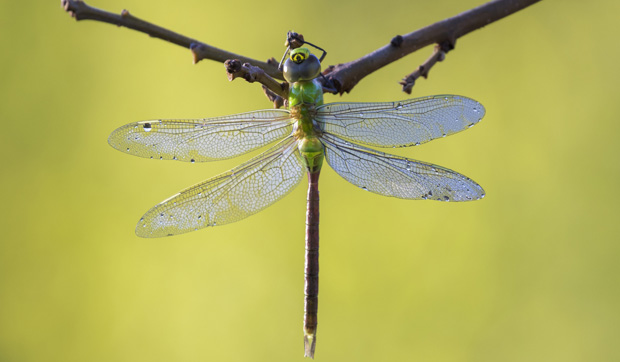The green darner, Anax junius, is the largest dragonfly in our area. Adults migrate to the warm South in winter; a new generation arrives back here in spring. Photo: mirceax
Good Natured: Migrating Dragonflies
September 22, 2023
Did you see them? They were everywhere! And they were AWESOME!
“They” were migrating dragonflies, heading south through our area as they move on to the next fascinating, though little-known, life stage.
I’d wager that just about everyone recognizes that many bird species migrate seasonally, moving northward in spring toward their summer breeding grounds and then, in fall, flying south toward assorted winter destinations. In fact I’ll even bet that most people are aware that monarch butterflies migrate too, fluttering their way to the mountains of central Mexico.
(Migration minutiae #1: Monarchs from eastern North America overwinter in oyamel firs high up in the Sierra Madre mountains in the Mexican states Mexico and Michoacan. Lepidopterists, or scientists who study butterflies and moths, became aware of the monarch’s migratory habits in the 1930s, but it wasn’t until the 1970s that Mexico was identified as the destination.)
The August 1976 issue of National Geographic magazine made the monarch’s trek famous. In fact I can still picture the cover of that issue, which I read about a hundred times in the library at Franklin Junior High in Wheaton…
At any rate, I’m fairly certain that few folks realize that lots of other insects migrate long distances too. The red admiral and the painted lady butterflies, for example, both members of the genus Vanessa and quite common in our area, move north and south seasonally, as do several sulphurs, a group of smaller yellow butterflies that includes my favorite, the dogface.
(Migration minutiae #2: Painted lady butterflies are no slouches when it comes to movement. Many U.S. individuals head to the deserts of northern Mexico, but recent research has shown that painted ladies in Africa fly, via successive generations, between the Africa and Europe-a trek of 7,500 to more than 8,000 miles, or roughly the same distance between Chicago and Hong Kong. Now that’s nothing to flutter at!)
Which brings us to the insects that inspired at least a dozen of you to contact Good Natured World Headquarters with your recent observations: Dragonflies.
As my buddy Paul put it, “Wow Pam, the Green Darner Dragonfly migration is ON. I saw hundreds swarming over my yard last night!
Later that same day my friend Amber sent in a video with the question, “Why do I have 100 dragonflies on one side of my yard, by the arborvitae trees?”
While we all consider dragonflies a standard part of summertime, in spring we rarely stop to figure out where they came from and often don’t notice in fall when they go away.
Granted, part of the reason for this lackadaisical attitude is that Illinois is home to nearly 100 dragonfly species. Of these, only a few are migratory; the rest are perfectly content overwintering as juveniles in the mucky bottoms of our local ponds and streams.
Muddying the picture further, some dragonflies live for years in that immature stage, crawling out and molting one last time on a schedule determined by factors known only by them.
Although various species of gliders, meadowhawks and saddlebags (yes that’s a type of dragonfly) migrate too, the species that’s being seen in the greatest numbers locally is the one Paul identified, the green darner or Anax junius.
(Minutiae #3: Darners get their common name from their resemblance to darning needles, which is exactly what my Grandma Erickson used to call them. Regarding their scientific name, Anax comes from the ancient Greek and means lord, master or king, and junius means young.)
Because the species is so common, and its range spans the US, scientists have spent quite a bit of time piecing together its life history. The current understanding is that its annual life cycle is made up of three different generations: the first emerges in early spring down south and flies north; the second emerges here and flies south; and a third, nonmigratory group that lives exclusively in the south.
Whether moving north or south, the average green darner travels about 550 miles, which is about the distance between Chicago and Birmingham, AL. Not surprisingly for such small creatures, their travel times are affected by temperature and windspeed. With ideal conditions they can buzz along at nearly 10mph and cover almost 90 miles per day.
(Minutiae #4: Many naturalists travel at speeds significantly slower. A few years back, for instance, it took me a week to go from Lexington KY to Paducah. Dragonflies, I suppose, ignore the allure of places like the Kentucky Reptile Zoo, the Red River Gorge and the Limestone Branch Distillery where, FYI, the tour is educational and the samples quite generous.)
The fall equinox is this weekend, on September 23rd. As you take stock of your favorite seasonal changes-the cooler temperatures, the turning leaves, the bugling sandhill cranes-don’t forget to add migratory dragonflies to your list. They are AWESOME!
Pam Otto is the outreach ambassador for the St. Charles Park District. She can be reached at potto@stcparks.org.

